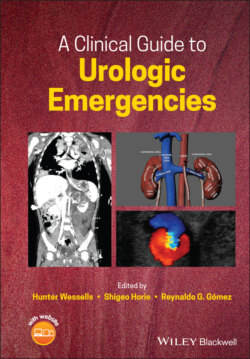Читать книгу A Clinical Guide to Urologic Emergencies - Группа авторов - Страница 30
Hypertension
ОглавлениеPatients who sustain renal injuries have an increased risk of renovascular hypertension, with the incidence of renal trauma‐related hypertension estimated between less than 1 and 5% [80109–113]. As a result, the European Association of Urology (EAU) Guidelines on Urologic Trauma, the AUA Urotrauma Guidelines, and the Societé Internationale d'Urologie (SIU)/World Health Organization (WHO) consensus statement on renal trauma all recommend periodic monitoring of blood pressure for the first year after injury, at least for a subset patients who have sustained high‐grade injuries [30, 37, 82].
Renovascular hypertension after trauma may develop through several mechanisms: renal arterial stenosis or occlusion, parenchymal compression caused by perinephric hematoma (Page kidney), or chronic scar formation [109, 111, 112]. All of these result in a reduction in renal blood flow, which can then cause a unilateral hypersecretion of renin and resultant hypertension [25]. Diagnosis can be made with selective angiography and renal vein renin levels. Older studies of renal trauma patients show rates of new‐onset hypertension of 4–5%, with onset between two weeks and eight months of injury [80, 112]. A more recent study contradicts these data, showing that patients who develop hypertension after renal trauma typically manifest it during their initial hospitalization and do not develop delayed hypertension during long‐term follow‐up [114].
Management with medications, renal artery bypass surgery, or partial or total nephrectomy has been shown to be effective [109, 111]. In studies evaluating conservative treatment, treatment rates range from 28 to 50% [111, 112, 114, 115]. In terms of surgical management, elevated renin levels from the affected kidney have been shown to predict a good response to surgical treatment [111, 116]. Similarly, one study showed that in cases of arterial stenosis or occlusion, early nephrectomy within the first year after injury had better response rates compared to delayed nephrectomy [108].
